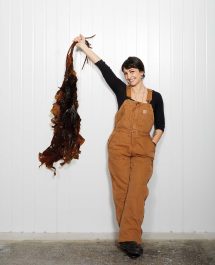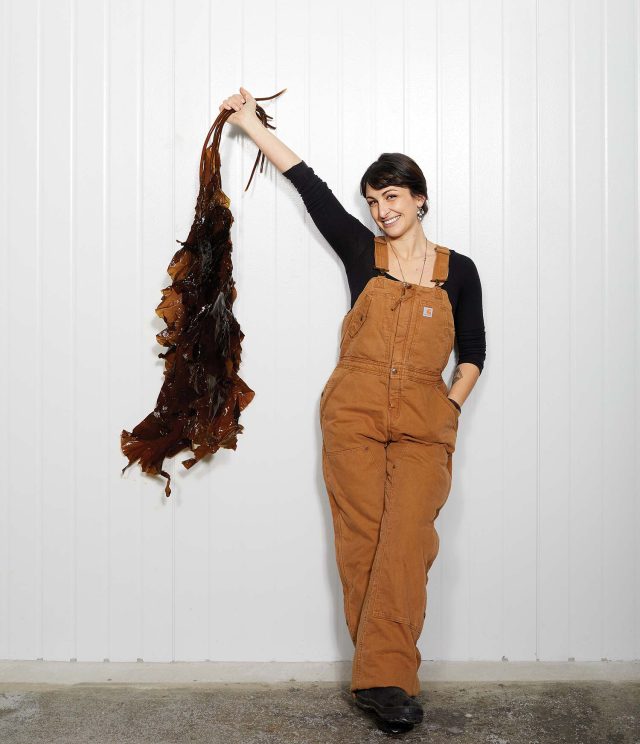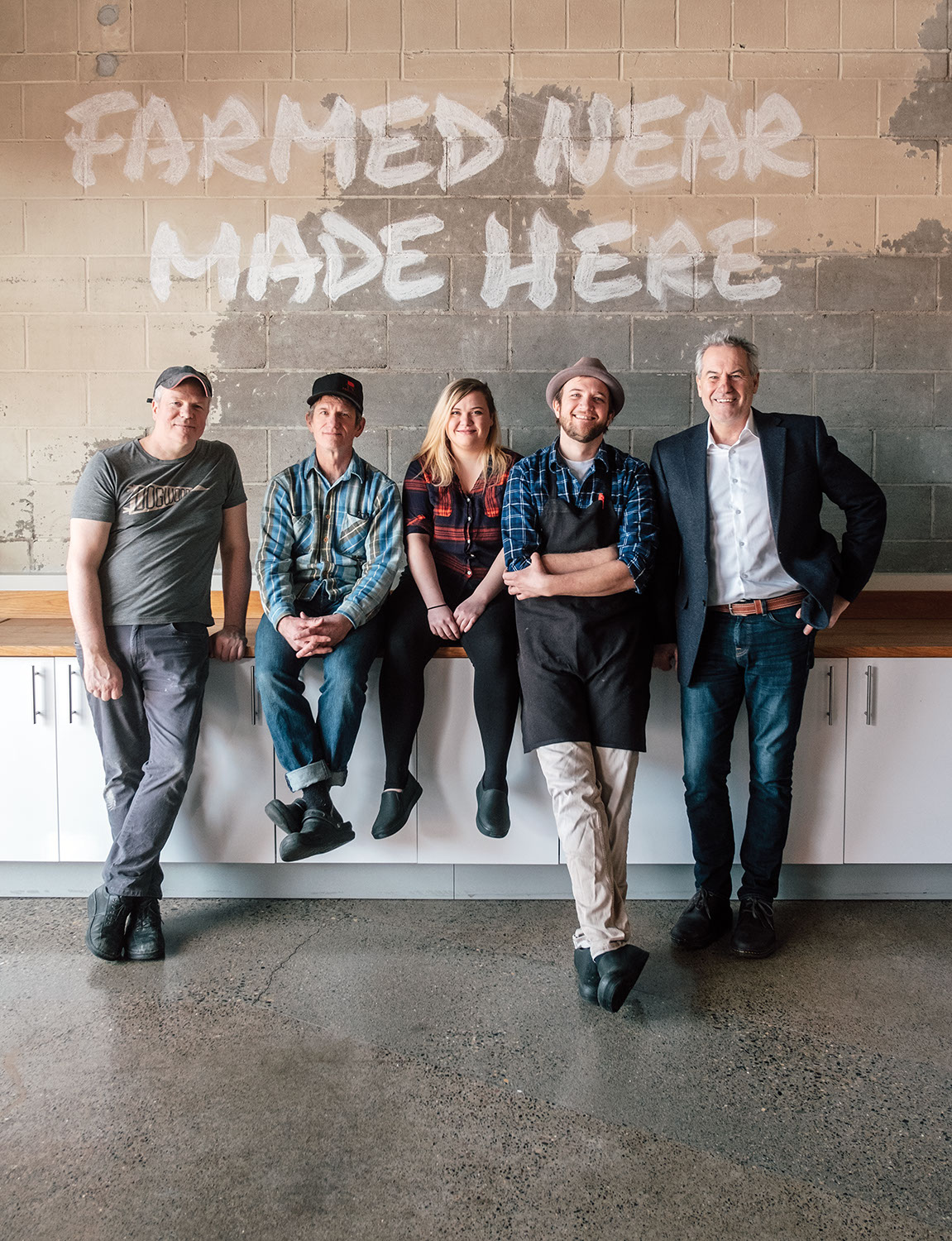 Meet the makers at the Minneapolis Food Building, an urban food production hub. From left to right: Steve Horton, Mike Phillips, Alexandra Adams, Ian Gray, and Kieran Folliard.
Meet the makers at the Minneapolis Food Building, an urban food production hub. From left to right: Steve Horton, Mike Phillips, Alexandra Adams, Ian Gray, and Kieran Folliard. STORY BY SANDRA S. SORIA ✷ PHOTOGRAPHS BY JONAS JUNGBLUT
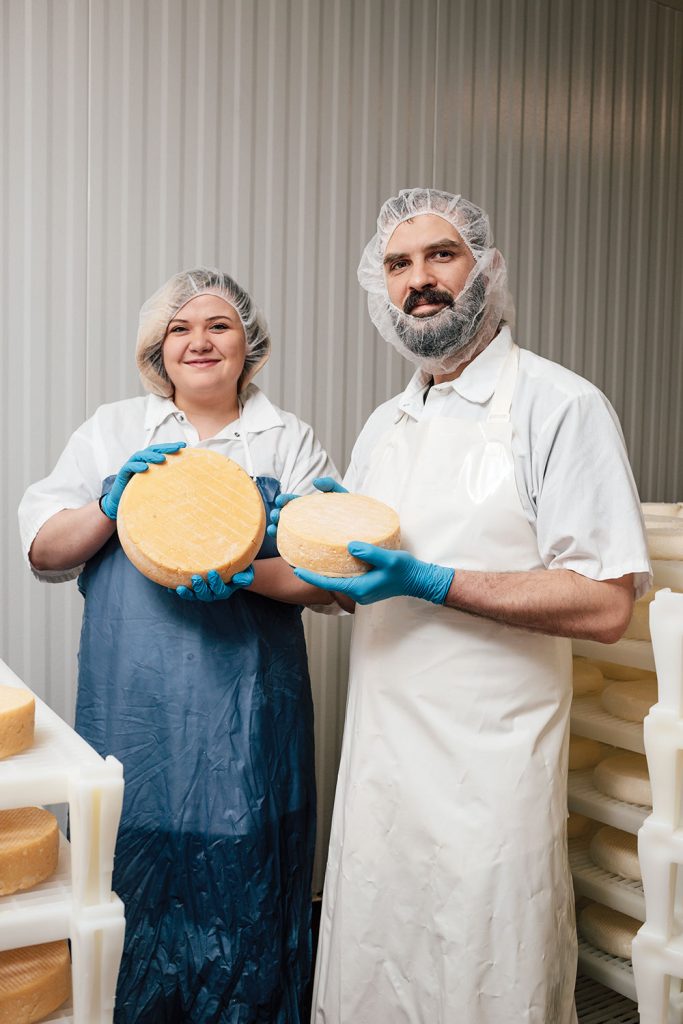
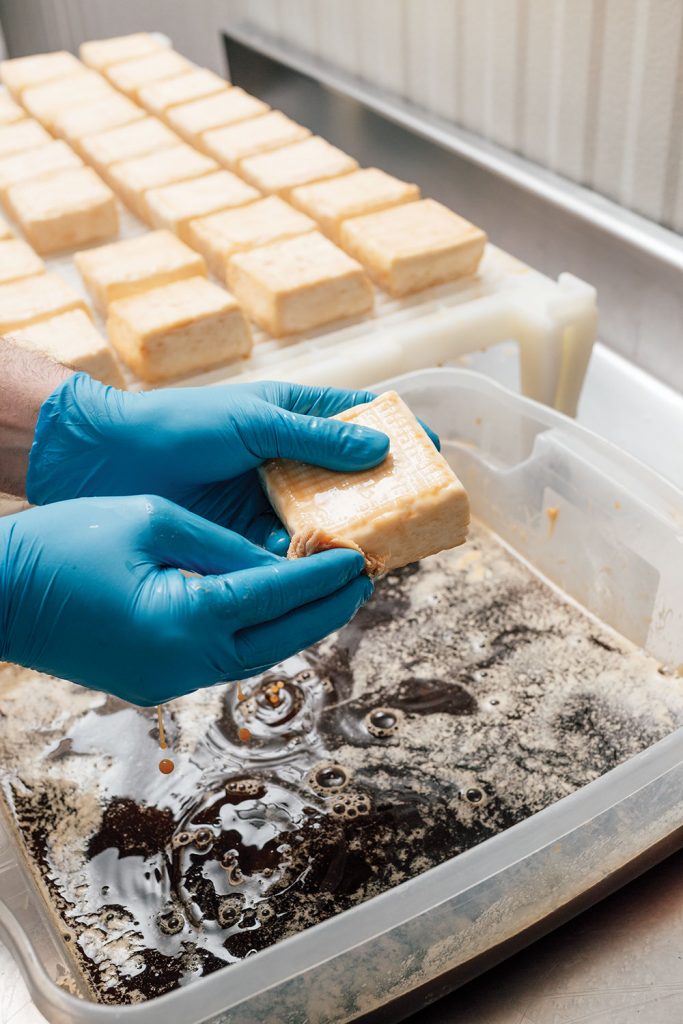
Alemar Cheese
There’s a lot of science and many precise steps involved in turning milk into cheese. But for the artisan cheese makers at Alemar, making their world-class, crave-worthy cheese starts well before the milk hits their shiny, stainless steel vats. It starts with grass. “From the very beginning, we’ve only worked with Minnesota family farmers who share our belief that grass is the only thing cows should be eating,” says Alexandra Adams, who started learning the art of small-batch cheese making at the ripe old age of 14 from her dad, founder Keith Adams. “There are other ways to get bigger cows and higher milk yields, but what matters more to us is the integrity of the diet. It’s a wonderful way to respect the earth and the cow, and to make the best possible product.”
This kind of ground-level integrity catapulted her father from a newbie to an award-winning cheesemaker within two years. His first creation, the Camembert-inspired Bent River cheese, won top honors from the American Cheese Society and was welcomed into fancy New York City restaurants and boutique cheese shops. “It was like if you entered the Olympic trials one day,” says Alexandra, “and then suddenly win the gold medal.”
The Bent River Camembert is still a fan favorite, but Alemar has added to its offerings with other fresh, soft-rind cheeses such as a spreadable Fromage Blanc. The Naturally team fell hard for their large-format brie, Good Thunder, which is washed in a brown ale from local Surly Brewing, borrowing a centuries-old technique that gives the cheese an umami boost. “It’s a process the monks would use in abbeys in Europe to make their cheese a kind of meat substitute when they were fasting,” says Alemar’s Head Cheesemaker Craig Hageman. “It has a culture that makes it a little stinky and gives it a copper rind.”
Those same Trappist monks shared another prominent teaching that isn’t lost on the folks at Alemar: “live by the work of your hands.” For Alexandra, who considers her current title “the wearer of many hats,” that idea was another lesson learned from her father. “Feeding someone gives you a satisfaction that’s just not comparable to anything else,” she says. “It transcends language even. There is a really special sort of bond that happens when you feed someone something incredibly delicious, especially if you made it yourself with your own two hands.”You can watch the magic happen at the Alemar plant in the Minneapolis Food Building, look for their cheese locally, or order it shipped to your doorstep from alemarcheese.com
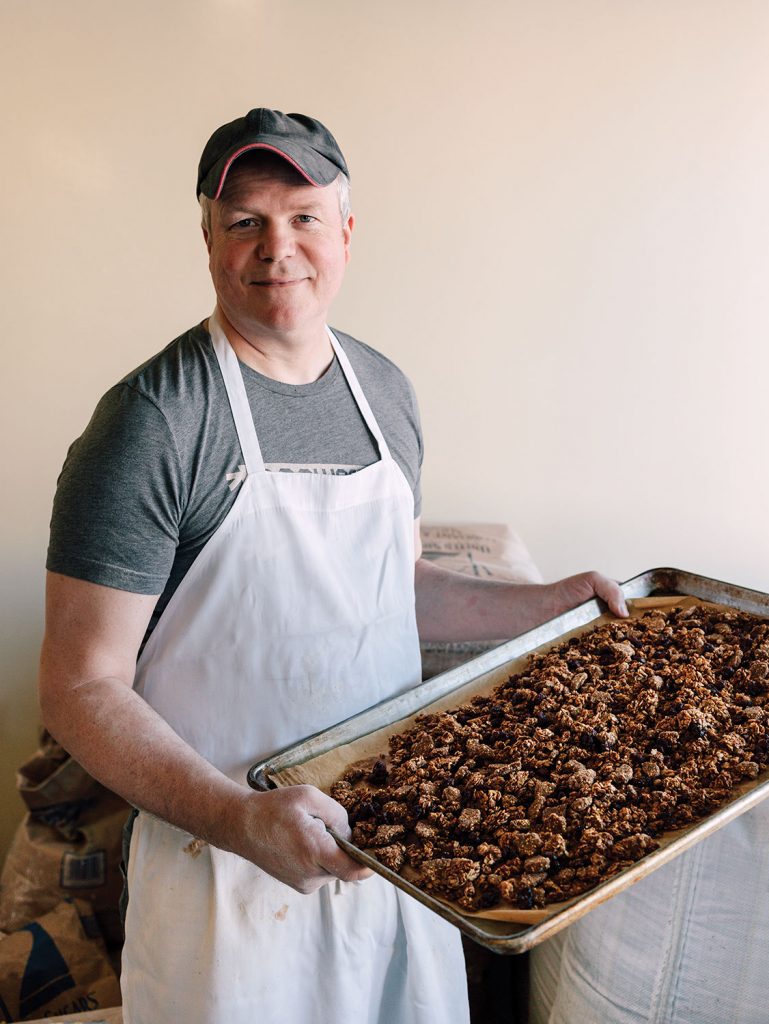
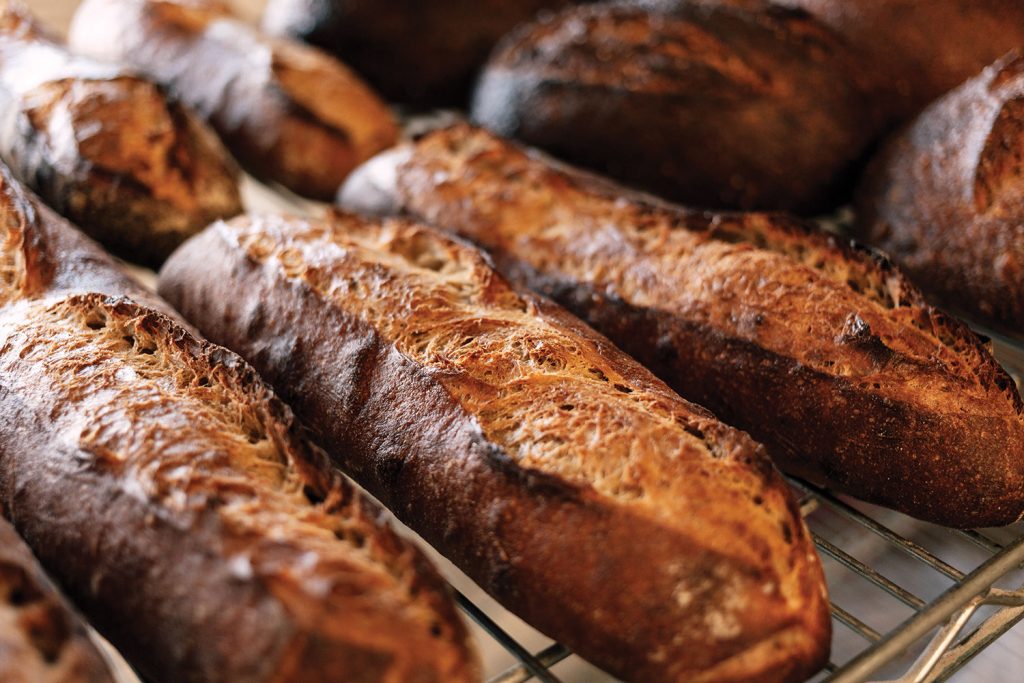
Baker’s Field Flour & Bread
When a baker sets up shop down the road from General Mills headquarters in a town nicknamed Mill City, you’d think he’d be satisfied with his flour options. But Steve Horton isn’t your run-of-the-mill baker by any stretch. The three-time James Beard finalist is considered one of the best bread makers in the country—and he’s not done perfecting his art.
And that’s where the flour folds in. “One of the ironies in the Twin Cities is that it’s difficult to find a variety of flour here because milling is really dominated by agribusiness,” Steve says. “But from a baker’s perspective, flour is your medium. And as I began to look at it, I was like, ‘The only real way for us to use different flours is if we mill them ourselves.’”
When a space opened up in the Food Building, Steve and the production hub’s founder, Kieran Folliard, went through an arduous months-long process of rezoning to allow Steve to set up a traditional stone mill in his bakery. Then, it took Steve and his team a full year to learn to operate the mill. But they’re now rolling out about 1,000 pounds a day of whole grain fresh flours that they bag up for consumers or bake up in their breads.
The idea was not only to make more nutritious flours, but fresher, tastier ones as well. “As flour sits, it oxidizes, and you start to lose flavor over time,” Steve says. “It’s like a ripe tomato that was picked yesterday at a farm and sold to you at a farmer’s market is going to have a lot more flavor in your salsa. It’s the base ingredient that creates something very interesting. That’s our approach.”
Being both miller and baker also lets Baker’s Field operate its own little, closed-loop food system. Steve has sought out grain farmers in the Upper Midwest that use organic or sustainable practices—another level of quality control, but also a way to support local farmers and the Earth in general. “For me personally,” Steve says, “it all starts with the soil, and if we’re stripping away all the nutrients or not maintaining the health of the soil, then we’re really not doing a service to our consumer and the planet in general.”
The proof of his dedication is on the plate. The difference between Baker’s Field breads and commercial loaves is like the gulf between a Hostess
Ho Ho and Grandma’s scratch cake. There are the superior ingredients, for sure, but there’s no discounting the love and care mixed in as well. There are no shortcuts or shortchanges that would be worth it in Steve’s world—he even eschews quick and consistent commercial yeast starters for natural fermentation methods, which means a loaf might take four days to rise. But sit down to a slice slathered in butter and be ready to taste transcendence.Stop in to the bakery to snag one of Baker’s Field’s loaves, bagels, or buns or order a bag of one of his multiple varieties of fresh, stone-milled flours to be shipped to your kitchen at bakersfieldflour.com.
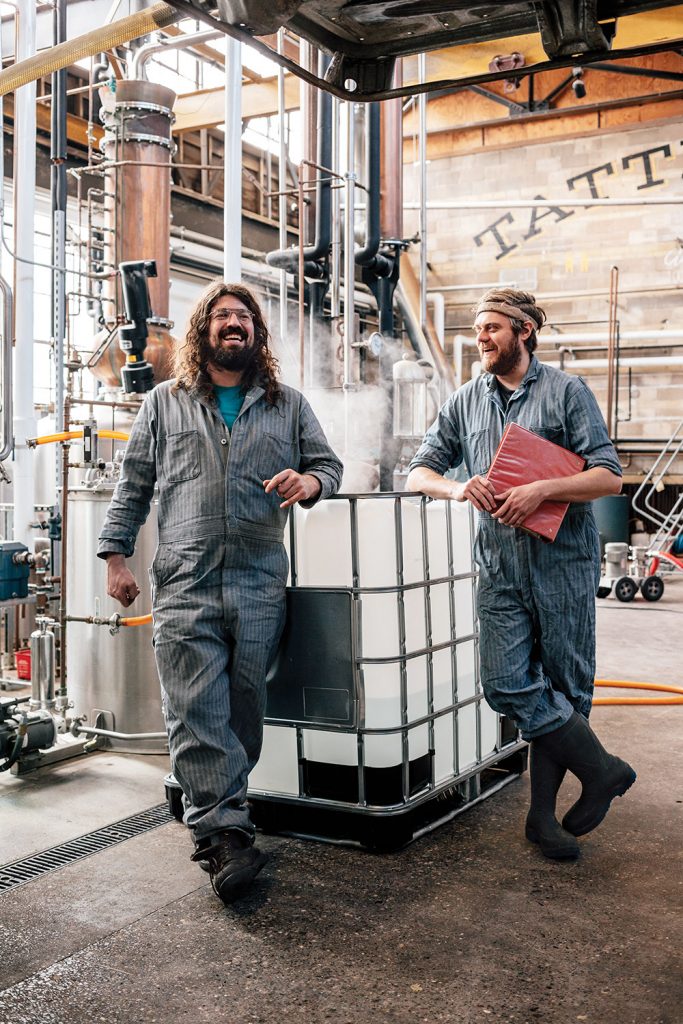
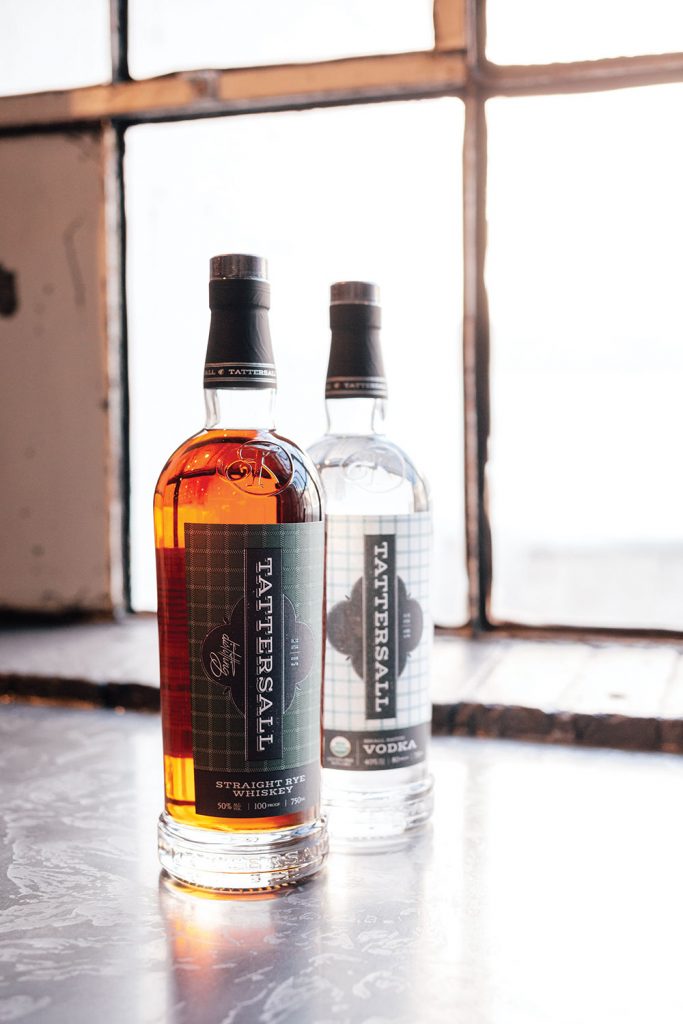
Tattersall Distilling
Looking for a way to more fully support organic Midwestern farmers? Pour yourself a stiff one made from Minneapolis-distilled Tattersall brand liquor. “Minnesota does well growing corn and rye—the number one and two inputs for distilling,” says Co-Founder and Chief Officer Jon Kreidler. “We source all of our organic corn and rye—between 20,000 and 30,000 pounds of grain per week—to two farms. So, we’re doing a lot more than making drinks, we’re impacting agriculture within the state as well.”
Turns out Minnesota isn’t just well-positioned for growing the ingredients, it’s an ideal place to distill them into high-quality spirits. For one, recent laws and lower licensing fees made the state more welcoming to small-batch, craft distilleries. For another, the state’s big chill and clear lakes are a double bonus. “You need cold air to cool down the steam and the vapors you’re making in the process,” Jon says. “So, it makes us more efficient. Wintertime is when we really crank on distillation.”
With an MBA and a background in assessing manufacturers for good investment potential, Jon was the guy to run these analytics and forge full steam ahead into the distillery business. He even knew the guy to partner with—childhood friend and local-legend bartender Dan Oskey. When they tapped “forager and fermentation guru” Bentley Gillman to be Distilling Manager, the A-team was complete.
Their line began with vodka, gin, and aquavit, but Tattersall now offers whiskey, rye, liqueurs…well pretty much you name it…and has hauled in enough medals to make Michael Phelps envious. Along the way, they’ve made it their business to make the often lofty world of the craft cocktail more accessible, first through a handy Tatersall app that puts 450 recipes at your fingertips. Now they’ve even done the mixing for you, with their novel “ready-to-drinks”—which simplifies the craft cocktail to a two-pour affair by distilling the liquors with an array of unique and even obscure botanicals (thank you, Bentley!). Add a splash of soda or a couple of cubes of ice and wow them at your next cocktail party.
You can toast the team by visiting the distillery’s industrial-chic cocktail room that lets you peek in at the distilling process. Or, pick up a bottle in one of 30 states to which they distribute. To learn more, visit tattersalldistilling.com.
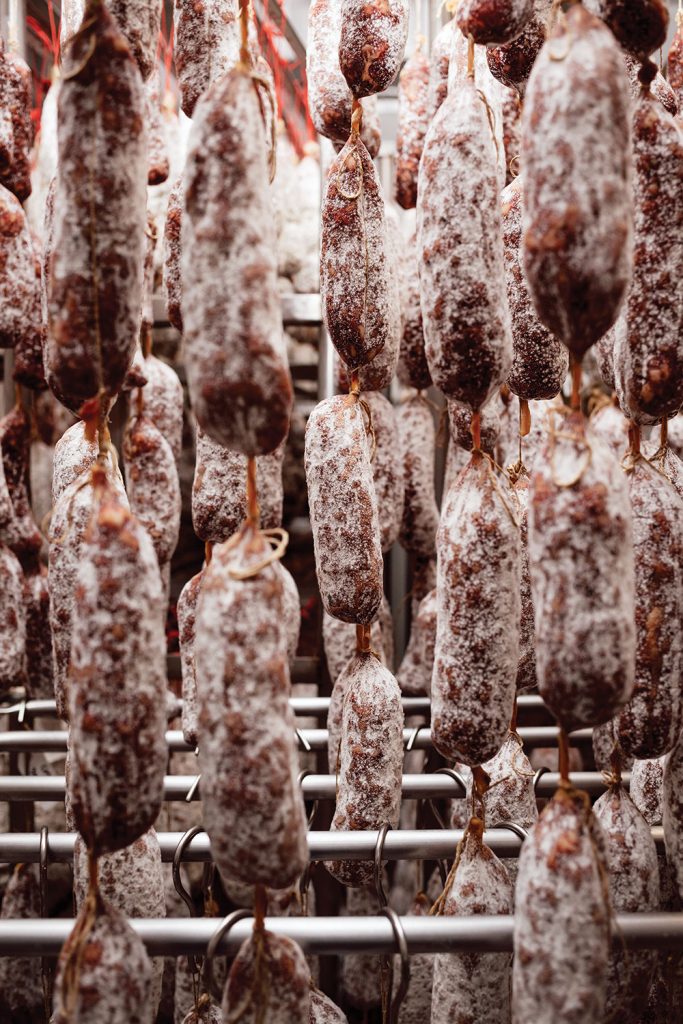
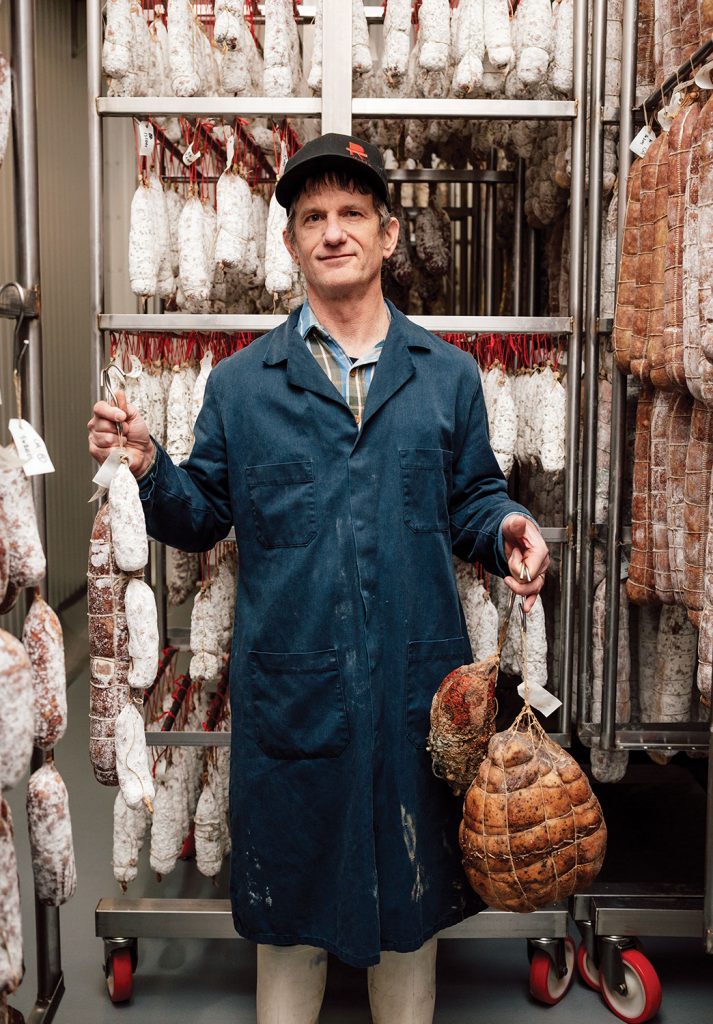
Red Table Meat
Red Table Meat’s owner Mike Phillips seems almost divinely chosen to be a salumiere (a person trained in the craft of preserving and salt-curing meats, called salumi in Italian). Growing up in rural Iowa with a cornfield for a backyard, he had a front-row seat to the ‘70s era farm crisis, giving him a deep appreciation for the toil and devotion—and fragility—of the small farmer. And the fact that he once dated the Clay County Fair Pork Queen surely had to be part of some master plan.
Then, as a young man, wanderlust had him traipsing over Europe, where he witnessed fierce pride in local food crafted using centuries-old wisdom. “I’d be in a little town in Italy and a bar fight would break out,” he remembers, “and it wouldn’t be over whose football team was best, it was over whose salumi was.”
It was sense of local pride that started him thinking that the heartland was perfectly positioned to create the best, brag-worthy cured pork in this country. “We have some of the best pigs in the world coming out of the Midwest,” he says. “And I was watching people from the coasts take our pork and make really great things, but there was nobody here. And why not? So, the easy answer for me was to create a business that made a world-class product to highlight that.”
Of course, not all Midwestern-raised pigs will do. He buys his pork from just a couple of nearby heritage suppliers and local farmers. “Pigs that aren’t happy and have had stressful lives really don’t produce good meat,” says Mike. “If it’s showing up in the end quality, you also know that something wasn’t going right there on the farm, so those aren’t the farmers to work with.”
But if the stars did have a guiding influence over the longtime chef and James Beard Award nominee, the luckiest one was a chance to meet and learn the art of curing meat from Francois Vecchio, an 80-something Swiss butcher who taught Mike and many of the top salumieri in the U.S. “He’s in large part responsible for the charcuterie revolution in the States,” Mike says. “He taught me that salumi has the same age curve as a really good cheese or really good wine; it’s somewhat good on the way up and somewhat good on the way down. But it’s got a peak when it’s at its best—and that peak is when it’s young and fresh and it cuts almost like a cooked sausage.”
Most of the salumi suspended in Mike’s locker are aged from 21 to about 75 days, depending on the size. But be ready: It will taste nothing like the past-its-prime, plastic-encased salami most of us are used to, thankfully. “The probiotics in the salumi haven’t died off yet,” he says. “So, the flora and the smell and that flavor are incomparable.”Try it for yourself by paying a visit to Red Table Meat, or have it shipped to your door via redtablemeatco.com.
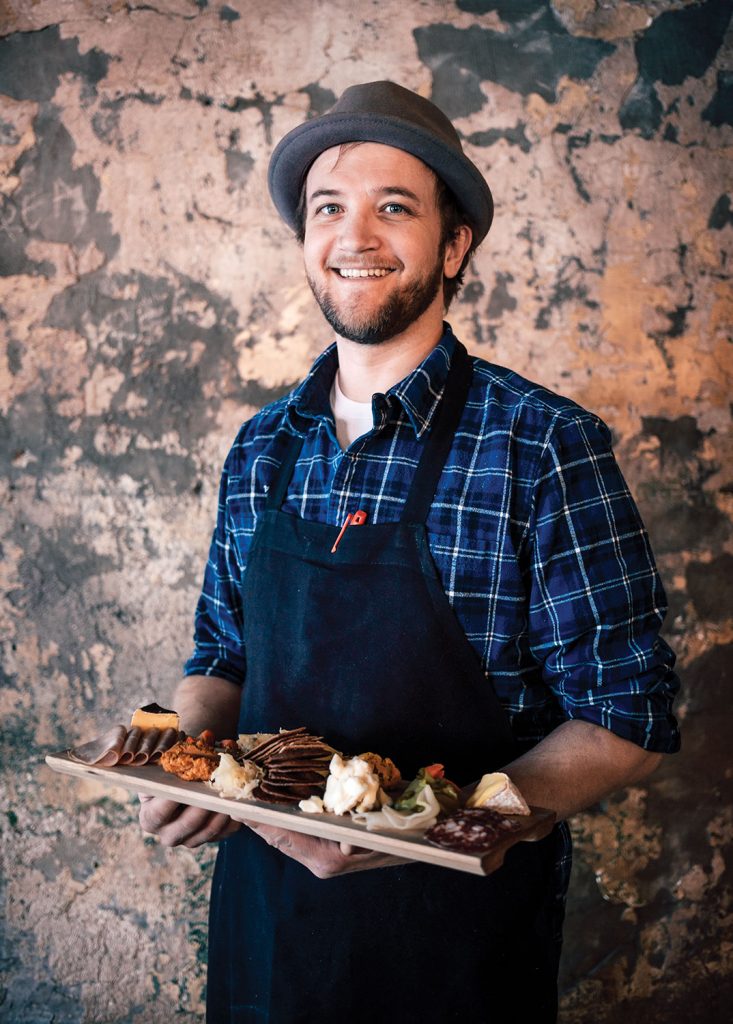
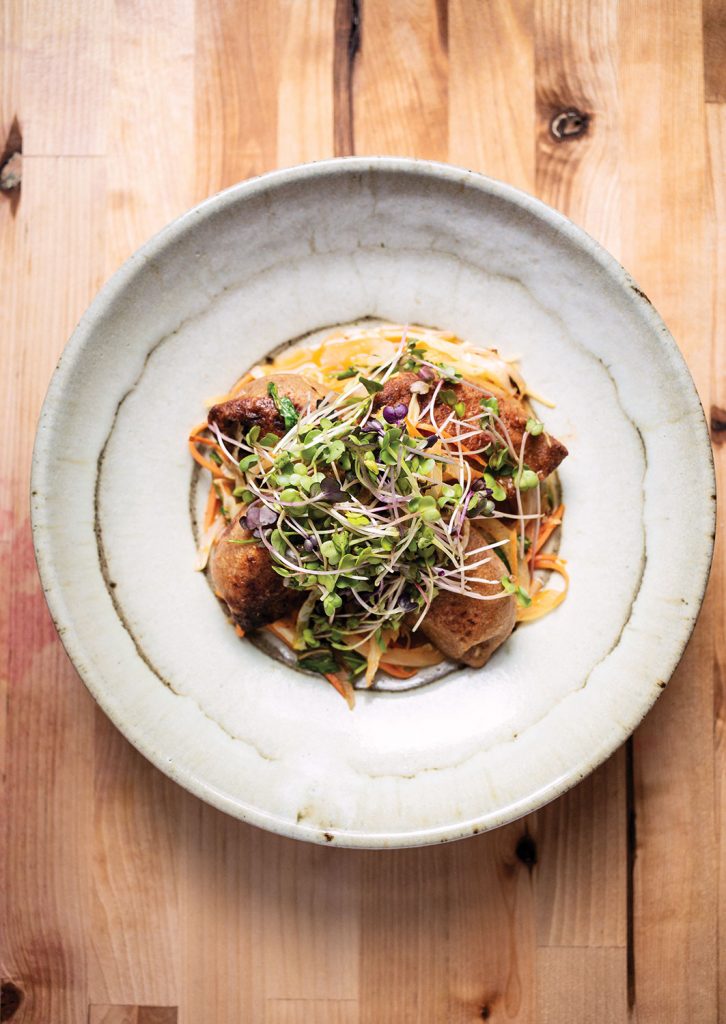
Kieran’s Kitchen
Concerned about where your food comes from? Dine at Kieran’s Kitchen and the answer is easy—right down the hall. Tucked into the Food Building—the urban food production hub founded by legendary Minneapolis restaurateur and whiskey maker Kieran Folliard—the recently opened market and counter-service eatery pulls many of its ingredients from the makers located in the building (and featured in this article). And the produce comes from within a 45-mile radius, some served the same day and others fermented for later. All are transformed into inventive and satisfying dishes by chef Ian Gray.
Seriously, when you’re making a sandwich from salami that might have been swinging from a hook an hour ago or creating pasta from flour that was stone-milled yesterday, that meal is
going to be memorable. Then there’s the next-level transparency: You can push back from that meal and stroll down the hall to watch the maker who cured the meat and take a few more steps to chat with the artisan who milled the flour.
And that’s only the end of the story, each of those makers has a personal relationship with the growers of the raw food that went into the ingredients of the meal you just consumed. Closing that loop was the whole point for Kieran, who brought a passion for traditional, small batch food—not to mention his charming brogue—from his native Ireland. “In general, these are what I would call historic or timeless type products that we are producing,” he says. “Something I think of that is timeless has value because it wouldn’t remain if it didn’t have that. But I also have always been attracted to projects of passion—pursuits that have meaning behind them.”
For Chef Gray, promoting the small farmer devoted to sustainable practices as well as the artisans dedicated to perfecting their food craft—by bringing them together on the plate—improves on the farm-to-table concept. “We’re trying to help shift a little bit of the narrative around food, especially when using the words local, natural, organic,” he says. “We want to pay tribute to the farmers, the growers, the makers. It’s really about the connections with the people as opposed to just, ‘Hey, it’s May and we have asparagus because we’re super local and super seasonal.’ When I have a relationship with a grower and he says, ‘Ian, come on out and pick all these peppers because they’re about to turn,’ that’s something different than just shopping farmer’s markets. We can ferment those and maximize the nutritional value and taste. Sure, I could put an order into Sysco—but that idea of convenience takes out the joy and real simplicity that is at the heart of food.” Wanna whet your appetite? Click over to foodbuilding.com or kieranskitchen.com.
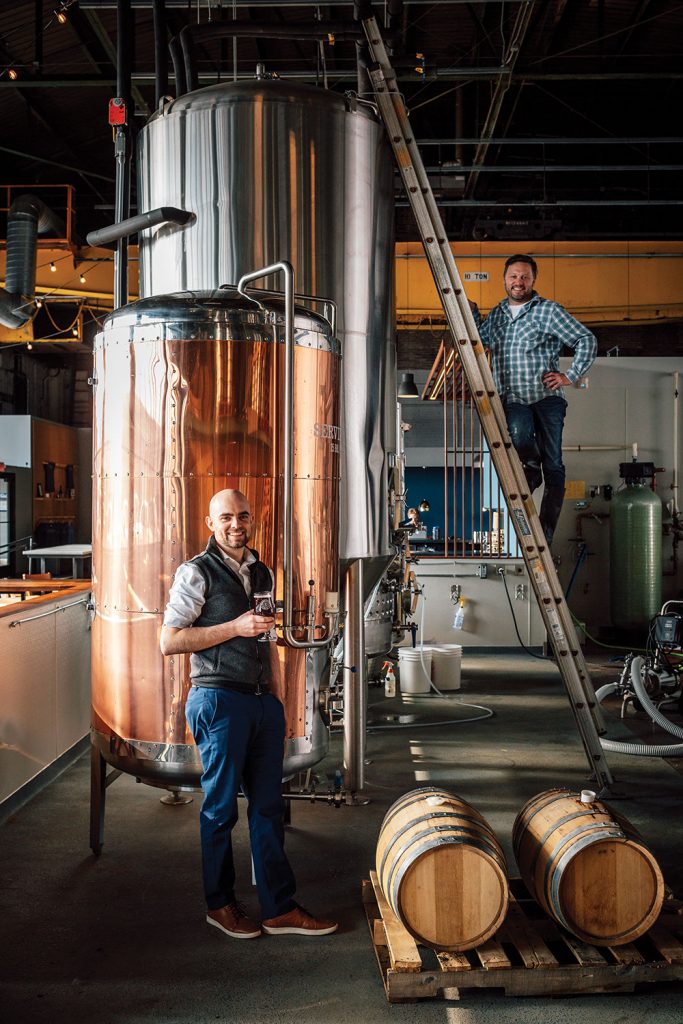
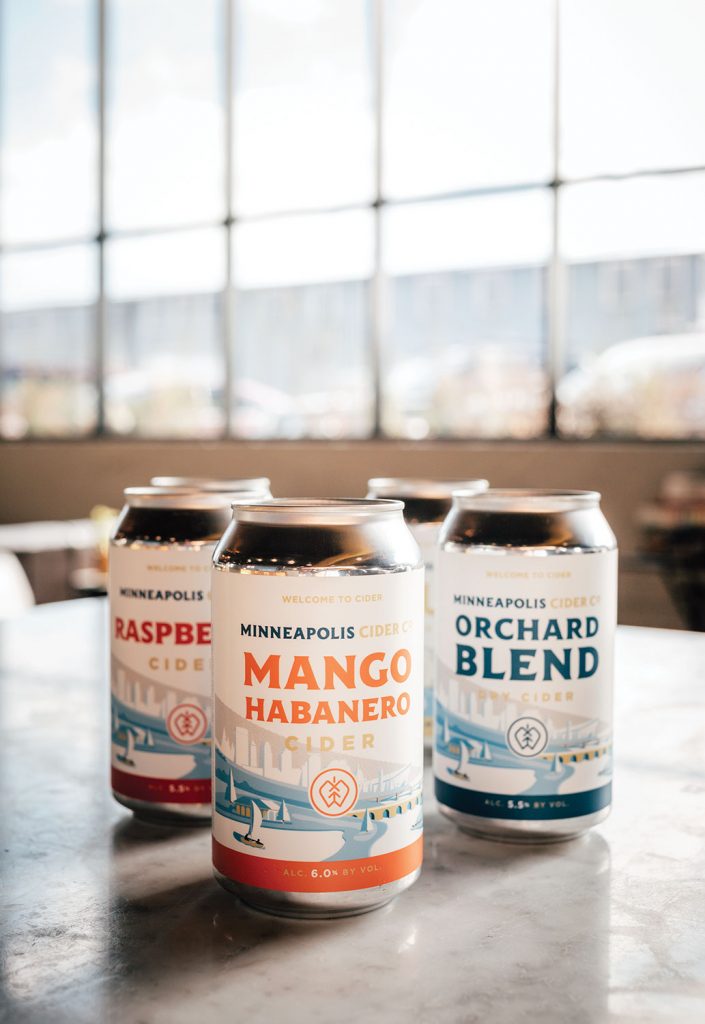
Minneapolis Cider Company
Like thousands of other students lucky enough to study abroad as part of the college experience, University of Minnesota college students Jason Dayton and David O’Neill came back from a semester in the U.K. with an expanded worldview in matters big and small. Perhaps most importantly for them, the two learned to drink like locals. And that important seed of knowledge later blossomed into a business. “I was 20 years old, running around the pubs,” says David, “and I came back loving cider—imagine that? I had never experienced it before in the U.S., never even heard of it. But I wasn’t a big beer drinker and I found it was basically discovering a drink that was social and approachable like a beer would be, but it was a little bit more complex with a flavor more similar to a wine.”
When they returned stateside and wanted to continue to drink their new favorite beverage, the two discovered that the choices were limited to sweet varieties. “I remember grabbing a six pack of Redd’s Apple and actually ended up getting ill,” David says. “The sugar content was several times higher than English cider. Jason had a similar experience.”
They took their preference for the English version further when the two business students teamed up in an entrepreneurial capstone course and convinced their professor to let them develop an idea for a company that produces alcohol. “It was unprecedented,” David says. “But long story short, our professor went on to become our first investor.”
They began experimenting with fermentation techniques in Jason’s basement, but quickly realized that the subterranean lab was okay for R & D, but wasn’t going to fly as a manufacturing facility. Partnering with a cidery out of Washington state, they ended up with their first batch—1,400 cases of canned cider trucked back to Minnesota on a semi—that they distributed to bars, liquor stores, and restaurants.
Last year, they took the leap to their own craft cidery, housed in a 15,000-square-foot warehouse on Minneapolis’s northeast side. They recruited Rob Fisk, a horticulture major at the U of M who had been making cider professionally for five years, as a full partner. He brought a connection to the agriculture and infrastructure of cider making. “Rob has worked at several orchards,” David says. “So, he has a really good connection to a lot of the agriculture scene. It’s really cool when he can just call up, say Pete from Minnesota Harvest Orchards, because he knows he’s picking and crushing a certain variety he wants and the owner, Skip, will drive them over in his truck. I mean we have really deep connections to a lot of our agriculture partners and that’s something we take a lot of pride in.”
Modeling after the myriad of craft breweries that have exploded onto the scene in recent years, they added a tap room to expose Angry Orchard drinkers—and beer fans—to the complexity of craft cider. In short, the students had graduated to educators. “We wanted to have a tap room,” David says, “where we could really craft that experience for people to come in and enjoy the product, educate them about what it is, show off all of our different styles, and really build kind of a brand and culture around what we were doing.”
For more info on their ciders—and their pioneering Royale spirits that are now part of the offerings—as well as the tap room, click over to minneapoliscider.co.

